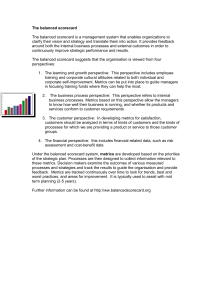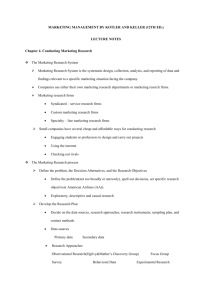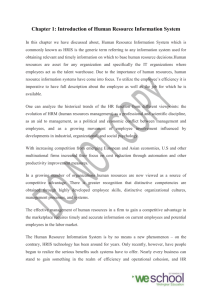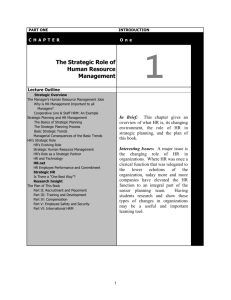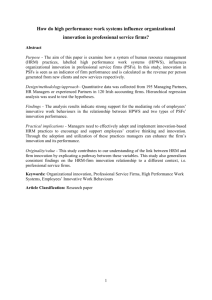PART ONE INTRODUCTION
advertisement
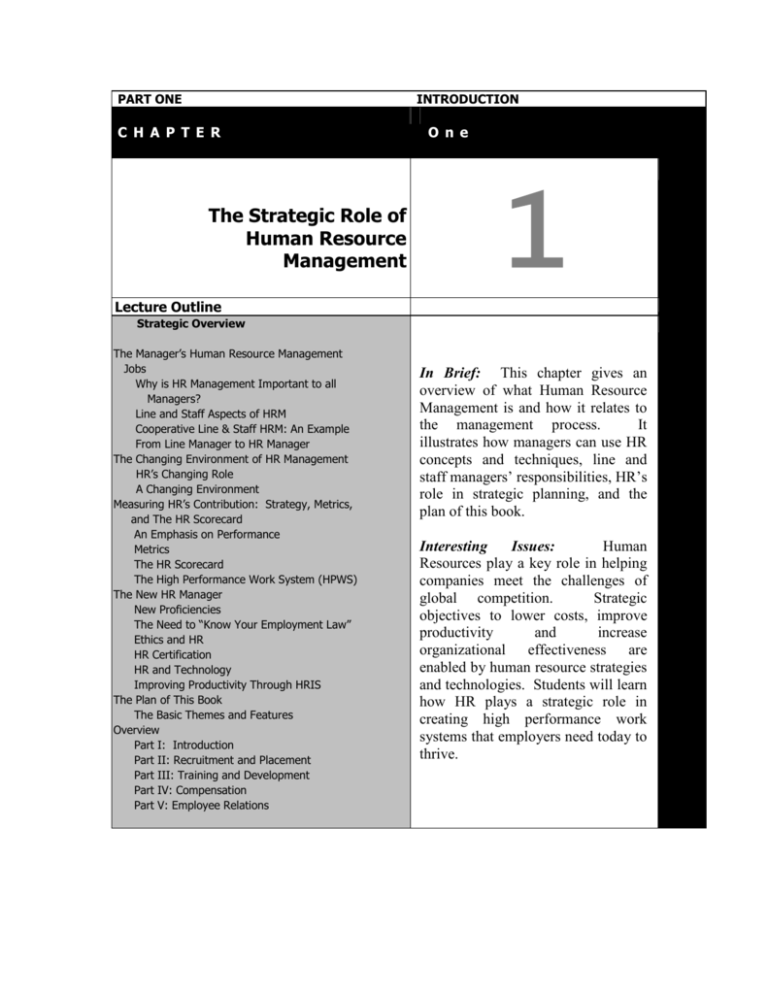
PART ONE INTRODUCTION C H A P T E R T The Strategic Role of Human Resource Management O n e 1 Lecture Outline Strategic Overview The Manager’s Human Resource Management Jobs Why is HR Management Important to all Managers? Line and Staff Aspects of HRM Cooperative Line & Staff HRM: An Example From Line Manager to HR Manager The Changing Environment of HR Management HR’s Changing Role A Changing Environment Measuring HR’s Contribution: Strategy, Metrics, and The HR Scorecard An Emphasis on Performance Metrics The HR Scorecard The High Performance Work System (HPWS) The New HR Manager New Proficiencies The Need to “Know Your Employment Law” Ethics and HR HR Certification HR and Technology Improving Productivity Through HRIS The Plan of This Book The Basic Themes and Features Overview Part I: Introduction Part II: Recruitment and Placement Part III: Training and Development Part IV: Compensation Part V: Employee Relations In Brief: This chapter gives an overview of what Human Resource Management is and how it relates to the management process. It illustrates how managers can use HR concepts and techniques, line and staff managers’ responsibilities, HR’s role in strategic planning, and the plan of this book. Interesting Issues: Human Resources play a key role in helping companies meet the challenges of global competition. Strategic objectives to lower costs, improve productivity and increase organizational effectiveness are enabled by human resource strategies and technologies. Students will learn how HR plays a strategic role in creating high performance work systems that employers need today to thrive. ANNOTATED OUTLINE I. The Manager’s Human Resource Management Jobs – The Management process involves the following functions: planning, organizing, staffing, leading, and controlling. Staffing involves: conducting job analyses; planning labor needs and recruiting job candidates; selecting job candidates; orienting and training new employees; managing wages and salaries; providing incentives and benefits; appraising performance; communicating; training and developing managers; building employee commitment; being knowledgeable about equal opportunity, affirmative action, and employee health and safety; and handling grievances and labor relations. A. Why Is HR Management Important to All Managers? Managers don’t want to make mistakes while managing areas such as hiring the wrong person, having their company taken to court because of discriminatory actions, or committing unfair labor practices. B. Line and Staff Aspects of HRM – Although most firms have a human resource department with its own manager, all other managers tend to get involved in activities like recruiting, interviewing, selecting, and training. 1. Line Versus Staff Authority – Authority is the right to make decisions, to direct the work of others, and to give orders. Line managers are authorized to direct the work of subordinates. Staff managers are authorized to assist and advise line managers in accomplishing their basic goals. HR managers are generally staff managers. 2. Line Managers’ HRM Responsibilities – Most line managers are responsible for line functions, coordinative functions, and some staff functions. C. Cooperative Line and Staff HR Management: An Example – In recruiting and hiring, it’s generally the line manager’s responsibility to specify the qualifications employees need to fill specific positions. Then the HR staff takes over. They develop sources of qualified applicants and conduct initial screening interviews. They administer the appropriate test. Then they refer the best applicants to the supervisor (line manager), who interviews and selects the ones he/she wants. D. From Line Manager to HR Manager: Line managers may make career stopovers in staff HR manager positions. II. NOTES Educational Materials to Use The Changing Environment of HR Management A. HR’s Changing Role – Human Resource responsibilities have become broader and more strategic over time as organizations' human resource requirements have become more complex. The role of HR has evolved from primarily being responsible for hiring, firing, payroll, and benefits administration to a more strategic role in employee selection, training and promotion, as well as playing an advisory role to the organization in areas of labor relations and legal compliance, B. A Changing Environment - Globalization of the world economy and other trends have triggered changes in how companies organize, manage and use their HR departments. 1. Globalization – refers to the tendency of firms to extend their sales, ownership, and/or manufacturing to new markets abroad. For businesses everywhere, the rate of globalization in the past decade has been enormous, and has several strategic implications for firms. More globalization means more competition, and more competition means more pressure to lower costs, make employees more productive, and do things better and less expensively. 2. Technological Advances – have been forcing, and enabling, firms to become more competitive. HR faces the challenge of quickly applying technology to the task of improving its own operations. 3. Exporting Jobs – has been prompted by competitive pressures and the search for greater efficiencies. 4. The Nature of Work – is changing due to new technological demands. In addition, the shift from producing products to producing and delivering services is a contributor to the change from “brawn to brains”. Dramatic increases in productivity have allowed manufacturers to produce more with fewer employees. In general, the jobs that remain require more education and more skills. The shift to using nontraditional workers such as those who hold multiple jobs, “contingent” or part-time workers or people working in alternative work arrangements has enable employers to keep costs down. 5. Human Capital – refers to the knowledge, education, training, skills, and expertise of a firm’s workers. There is a growing emphasis on the importance of knowledge workers and human capital and the HR management systems and skills needed to select, train, and motivate these employees. 6. Workforce demographics – are changing. The workplace is becoming more diverse as increased numbers of women, minoritygroup members, and older workers enter the workforce. The aging labor force presents significant changes in terms of potential labor shortages, and many firms are instituting new policies aimed at encouraging aging employees to stay, or at attracting previously retired employees. NOTES Educational Materials to Use III. Measuring HR’s Contribution: Strategy, Metrics, and the HR Scorecard – HR’s central task is always to provide a set of services that make sense in terms of the company strategy. Trends of globalization, increased competition, a changing workforce and more reliance on technology have two main implications for how companies now organize, manage, and rely on their HR operations. First, HR managers must be more involved in partnering with their top managers in designing and implementing their companies’ strategies. Second, the focus on operational improvements means that all managers must be more adept at expressing their departmental plans and accomplishments in measurable terms. A. An Emphasis on Performance – Management expects HR to provide measurable, benchmark-based evidence for its current efficiency and effectiveness, and for the expected efficiency and effectiveness of new or proposed HR programs. Management expects solid, quantified evidence that HR is contributing in a meaningful and positive way to achieving the firm’s strategic aims. B. Metrics – HR managers need a set of quantitative performance measures (metrics) they can use to assess their operations. These metrics allow managers to measure their HR units’ efficiency. C. The HR Scorecard – is a concise measurement system, showing quantitative standards or “metrics” used to measure HR activities, employee behaviors resulting from these activities, and to measure the strategically relevant organizational outcomes of those employee behaviors. The scorecard highlights the causal link between HR activities, emergent employee behaviors, and the resulting firm-wide strategic outcomes and performance. D. The High Performance Work System (HPWS) – The general aim of the HPWS is to maximize the competencies and abilities of employees throughout the organization. IV. NOTES Educational Materials to Use The New HR Manager A. New proficiencies – are required of the HR Manager today in: human resources, business, leadership, and learning. B. The Need to “Know Your Employment Law” – is increasingly important as a growing web of HR related laws effects virtually every HR decision. Equal employment laws, occupational safety and health laws, and labor laws are among the areas in which HR professionals need to be knowledgeable. C. Ethics and HR – have gained increasing exposure as a result of ethical lapses in corporate behavior. It is clear that ethics needs to play a bigger role in managers’ decisions. HR has an important role in promoting ethical behavior at work and will be explored more fully later in the text. D. HR Certification – through the Society of Human Resource Management has become increasingly important as human resource management is becoming more professionalized. Certifications of PHR (professional in HR) and SPHR (senior professional in HR) are earned by those who successfully complete all the requirements of the certification program. E. HR and Technology – Technology improves HR functioning in four main ways: self-service, call centers, productivity improvement, and outsourcing. More firms are installing Internet and computer-based systems for improving their HR operations. Technology also makes it easier to outsource HR activities to specialist service providers by allowing them to have real-time Internet-based access to the employer’s HR database. Improving Productivity Through HRIS – The HR Portal. HR portals provide employees with a single access point or “gateway” to all HR information. Portals streamline the HR process, enables HR to redeloy its assets focus more on strategic issues IV. NOTES Educational Materials to Use The Plan of This Book – Each topic interacts with and affects the others, and all should fit with the employer’s strategic plan. A. The Basic Themes and Features - HR is the responsibility of every manager - HR managers must defend plans and contributions in measurable terms - HR systems must be designed to achieve the company’s strategic aims - HR increasingly relies on technology to achieve the strategic aims - Virtually every HR decision has legal implications - Globalization and diversity are important HR issues today V. Overview A. Part 1: Introduction 1. 2. 3. Chapter 1: The Strategic Role of Human Resource Management Chapter 2: Equal Opportunity and the Law Chapter 3: Strategic Human Resource Management and the HR Scorecard B. Part 2: Recruitment and Placement 1. 2. 3. 4. Chapter 4: Job Analysis Chapter 5: Personnel Planning and Recruiting Chapter 6: Employee Testing and Selection Chapter 7: Interviewing Candidates C. Part 3: Training and Development 1. 2. 3. Chapter 8: Training and Developing Employees Chapter 9: Performance Management and Appraisal Chapter 10: Managing Careers D. Part 4: Compensation 1. 2. 3. Chapter 11: Establishing Strategic Pay Plans Chapter 12: Pay for Performance and Financial Incentives Chapter 13: Benefits and Services E. Part 5: Employee Relations 1. 2. 3. 4. Chapter 14: Ethics, Justice, and Fair Treatment in HR Management Chapter 15: Labor Relations and Collective Bargaining Chapter 16: Employee Safety and Health Chapter 17: Managing Global Human Resources

